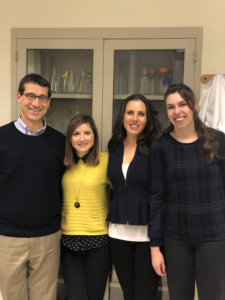Innovative device could power smaller, faster trials for Duchenne muscular dystrophy and open clinical trial participation to broader range of patients
A key focus of our work at Charley’s Fund is to improve the tools and resources drug developers use to identify and advance promising therapies. Electrical Impedance Myography (EIM) is a technology that offers a fast and painless way to evaluate muscle health. It has been gaining traction as a promising clinical trial outcome measure in other neuromuscular diseases like ALS and SMA. We have been supporting the work of Dr. Seward Rutkove, EIM’s scientific pioneer, to evaluate its efficacy in DMD. A new publication available in the Annals of Clinical and Translational Neurology features important findings supporting EIM’s potential. We sat down with Dr. Rutkove to discuss the results and what’s next for EIM and its potential to improve clinical trials in DMD.
Charley’s Fund: Let’s catch up anyone who hasn’t yet been following your research. Could you recap for us what EIM is and why it has particular appeal as an outcome measure?

EIM pioneer Dr. Seward Rutkove with Charley’s Fund president and COO Laura Dalle Pazze (second from right) and research collaborators from our Of Mice and Measures effort — which is testing EIM in mice too!
Dr. Rutkove: EIM is a fast (~20 minutes or less, depending on how many muscles you measure), relatively inexpensive, easy-to-perform measure that collects objective data and can be performed on almost anyone. It passes a painless electrical current through a muscle and records data documenting what happens to the current to help us evaluate the state of the muscle. It’s performed using a simple hand-held device, so it is free from a number of limitations that impact other outcome measures — like is a boy too young to focus for a test of how far he can walk, or so advanced that his contractures mean he can’t fit in an MRI machine.
Charley’s Fund: And that’s especially important in DMD. So many studies now focus on boys in a very narrow age or functionality range. Expanding the pool of potential participants not only helps us ensure we develop drugs that work for all boys with Duchenne — a bigger pool of potential trial recruits means faster trial recruitment.
Dr. Rutkove: That’s right. When we began this effort to explore the potential of EIM, our early studies assessed and confirmed EIM’s reliability: We had to make sure that different people using the EIM device on the same muscles get the same results, and we also had to confirm that when the same person repeats the measure, he or she gets the same result both times. We also generated data confirming that EIM can differentiate between boys with and without DMD, and track DMD’s progression over time.
Charley’s Fund: What’s important about the findings in this latest publication?
Dr. Rutkove: Several things. First of all, with Charley’s Fund’s help, we wanted to analyze EIM’s potential to work in a broader range of boys and young men with DMD. And importantly, the findings here confirmed that EIM can indeed help broaden access to clinical trials regardless of ambulatory status. Second, we confirmed that EIM robustly correlates to a more well-known outcome measure, the timed supine-to-stand test, which is helpful validation for those accustomed to traditional measures. Third, we confirmed that EIM’s level of sensitivity to detect presumably disease-driven changes in muscle could help power smaller, faster trials than traditional measures such as 6MWT – and with added appeal due to its relatively low cost, portability, and ease of use (for both patients and medical teams).
Charley’s Fund: This could help address a tremendous need felt throughout our community – both for all the patients who want to participate in trials but currently may be left behind, and for trial sponsors and researchers who need objective, effective measures that can help them design broadly relevant, effective studies. So what’s next?
Dr. Rutkove: There are two important additional points of progress to mention first: One, we actually have an even better version of the device in prototype now. Two, we’re in the process of getting that new and improved version approved by the FDA as a medical device. This will streamline the process for clinical trial sponsors who want to use it in their trials and doctors who want to use it in their clinics.
From here, what we really need is for clinical trial sponsors to include EIM in their trials as an exploratory measure. EIM can help drug developers identify whether a drug is promising enough to advance to a bigger trial more quickly, and with fewer boys, than if they used a more commonly accepted functional outcome measure. Since it’s more sensitive than current primary outcome measures like the 6MWT, even if a sponsor didn’t see a result using the 6MWT, EIM may pick one up. Conversely, it may also help identify early when to cancel a program that’s not working. All this could help companies better identify the most effective potential new therapies that truly warrant resources for a full trial. Ultimately, we hope EIM could serve as an accelerated approval biomarker, so the more data we can gather showing its sensitivity to disease progression and drug effect, the faster we build a case to support this.
Charley’s Fund: Thank you for your dedication to pursuing this as a way to help families with Duchenne. We are really glad to hear all of this and eager for more doctors and research teams to take advantage of these findings to help advance their programs. We also want to thank our partner organizations Nash Avery Foundation, Ryan’s Quest, Michael’s Cause, and Pietro’s Fight for their commitment to helping us vet and advance EIM’s potential. When our community comes together to tackle big needs like this, we can accomplish a lot.
Interested in learning more or supporting this work? Contact Charley’s Fund President and COO Laura Dalle Pazze at laura[at]charleysfund.org.
